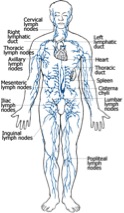What is Lymphoedema?
Lymphoedema is the accumulation of excessive amounts of protein-rich fluid resulting in swelling of one or more regions of the body.
This is due to a mechanical failure of the lymphatic system and occurs when the demand for lymphatic drainage is greater than the capacity of the lymphatic circulation. The condition usually affects one or both limb(s) although it may also involve the trunk, breast, head and neck or genital area.

What is the lymphatic system?
The lymphatic system is a network of vessels and nodes throughout the body that transports fluid (lymph) from the body tissues back to the bloodstream.
The functions of the lymphatic system are to maintain the volume and protein concentration of the extracellular fluid in the body and to assist the immune system in destroying bacteria and removing waste products from the tissues. The fluid is pushed from the hands or feet up the body towards the heart where the heart pumps the fluid out of the body and deposits it as waste fluid when you go to the toilet.
What Causes Lymphoedema?
Lymphoedema may arise because the lymphatic vessels or nodes have been damaged or were not formed correctly.
Secondary lymphoedema is the most common type developing following damage to the lymphatic system. The damage may occur as a result of some cancer treatments including the removal of lymph nodes, following radiotherapy to lymph node groups or with the progression of a spreading disease/s. The onset of lymphoedema may be at any time. It may occur within months of the damage or it may appear years later.
Secondary lymphoedema may also arise without a cancer diagnosis when one or more of the following conditions occur:
- Trauma and tissue damage
- Venous (Veins) disease
- Immobility
- Self-harm
- Infection such as cellulitis
- Lymphatic Filariasis – A major cause of lymphoedema in the sub -tropical areas of the world. Parasitic filarial worms are transmitted through mosquito bites. The parasites lodge in the lymphatic system causing destruction of the healthy vessels and nodes, resulting in lymphoedema.
Primary Lymphoedema is the result of a congenital condition that affects how the lymph vessels where formed. This may result in a reduced number of lymphatic vessels, the vessels are too large to be functional or the vessels are absent from part of the lymphatic system.
Signs and Symptoms
Signs and Symptoms to be aware of include;
- Transient swelling of a limb or other region of the body.
- Aching
- Heaviness
- Stiffness
- Limitation of movement,
- Tightness or temperature changes.
- Clothing, jewellery or shoes may feel tighter.
- Some people report pain and tension in an affected limb or body part.
- Lymphoedema can often be aggravated by heat, at the end of the day, with overuse, with sustained positions and prolonged inactivity.

Risks associated
Lymphoedema is understood to be a progressive disease and early intervention is recommended to minimise time and age related changes.
The swelling may progress without treatment which makes the skin more prone to thickening and the development of fibrosis and other secondary changes.
When the lymphatic impairment causes the lymph fluid to exceed the lymphatic system’s ability to transport it, an abnormal amount of
protein-rich fluid collects in the tissues of the affected area. If this is left untreated, this fluid causes tissue channels to increase in size and number, reducing the availability of oxygen. This interferes with wound healing and provides a rich culture for bacterial growth that can result in infections.
How do I manage Lymphoedema?
The aims of lymphoedema treatment are to prevent progression of the condition, to reduce oedema and then maintain the improvement. This includes the improvement of associated symptoms, prevention of infection and improvement of function and quality of life.
Lymphoedema cannot be cured but it can be improved and managed with appropriate intervention. The stage, location and severity of the lymphoedema together with the individual circumstances of the client will influence the most appropriate intervention. Early intervention is recommended.
- Exercise (30mins a day)
- This will help the heart pump harder and faster and allow the protein-rich fluid to be pumped from the body.
- If you are at risk of upper limb lymphoedema, ask your Physiotherapist about specific arm exercises you may be able to perform.
- Avoid skin surface scratches
- If you manage to scratch yourself ensure you clean the area straight away to avoid any infection.
- This includes scratches from animals, objects or even scratching your own skin.
- Avoid insect bites
- Use skin protection repellents to avoid being bitten or obtaining an infection.
- Having swelling around the area can reduce lymph flow causing you to become more susceptible to lymphoedema.
- Avoid Tight Clothing
- It is important that you avoid any form of tight clothing or jewellery.
- E.g. Upper limb, avoid tight jewellery, watches etc.
- E.g. Lower Limb, avoid tight shoes, socks and belts
- This allows lymph fluid to flow much easier and not become restricted
- Avoid high exposure to sunlight
- High UV exposure can reduce lymph flow due to heating purposes and increase your risk of lymphoedema.
- Ensure to cover up appropriately when in the sun
- Moisturise Skin daily
- Ensure you moisturise your skin daily with cream (vitamin E) cream to prevent your skin from becoming dry.
- You are at increased risk of cuts/scratches to your skin if it becomes too dry.
- Compression
- If you do start to see signs of lymphoedema, be sure to ask your Physiotherapist about specialised compression garments that can be used.
NOTE: Do not use any ordinary type of compression bandage as it may do more damage.
Other forms of treatment if your lymphoedema progresses are massage (therapist and taught self-massage) and Manual Lymphatic drainage which is performed by your Physiotherapist or Lymphoedema Specialist.
